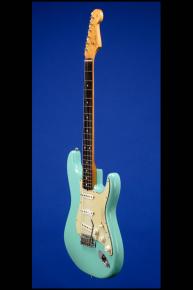A 1961 Slab Board Stratocaster…
This 12 3/4-inch-wide guitar weighs just 7.60 lbs. and has a nut width of 1 5/8 inches and a scale length of 25 1/2 inches. Solid alder body, contoured on back and lower bass bout, and professionally refinished many years ago most probably by Jay Black in the super rare Fender custom color, 'Sea Foam Green' over 'fullerplast'. One-piece maple neck with a rosewood 'slab' fret-board and a medium-to-thin profile, 21 frets, and clay dot position markers. Small headstock with decal with Fender "spaghetti" logo in gold with black trim, "STRATOCASTER" in black beside it, "WITH SYNCHRONIZED TREMOLO" in black below it, two patent numbers below that, and "ORIGINAL Contour Body" at the ball end of the headstock. Individual single-line Kluson Deluxe tuners with oval metal buttons (stamped on the underside: "D-169400/Pat No."). Single "butterfly" string tree with 'small' metal spacer. Four-bolt neck plate with the serial number ("58054") between the top two screws. Three white ABS plastic covered black-bottom single-coil pickups with staggered polepieces and wonderfully balanced outputs of 6.06k, 5.88k, and 5.95k. The pole-pieces are staggered as follows: (highest to lowest) D+G; low E+A; high E; and finally B. Three-layer celluloid "green" (white/black/white) pickguard with eleven screws and aluminum shield. Three controls (one volume, two tone) plus three-way selector switch, all on treble side of the pickguard. White ABS plastic knobs with gold lettering. Six-pivot bridge/vibrato unit with through-body stringing. The neck has a pencil mark of "1-61". The potentiometers are all stamped "304 6104" (Stackpole, January 1961). The capacitor is the correct red round disc type. There is some fine finish checking on the body and on the front and back of the headstock. The frets look to be original and do show some very light wear - BUT we believe that the neck has been so expertly re-fretted with the correct .08 gauge fret-wire, that it is impossible to tell… The original 'minty' pickguard has a small crack on the bass side of the neck pickup screw and one corner has broken away from the white ABS plastic tremolo back-plate. Because of the re-fin we can only give this guitar an excellent plus (9.00) rating - it shows, plays and sounds much stronger… Complete with the original white ABS plastic tipped tremolo arm. Original Fender light brown tolex hardshell case with brown leather ends and orange plush lining (8.50).
"The Stratocaster was launched during 1954 [and was priced at $249.50, or $229.50 without vibrato]...The new Fender guitar was the first solidbody electric with three pickups [Gibson's electric-acoustic ES-5, introduced five years earlier, had been the overall first], meaning a range of fresh tones, and featured a new-design vibrato unit that provided pitch-bending and shimmering chordal effects. The new vibrato -- erroneously called a 'tremolo' by Fender and many others since -- was troublesome in development. But the result was the first self-contained vibrato unit: an adjustable bridge, a tailpiece, and a vibrato system, all in one. It wasn't a simple mechanism for the time, but a reasonably effective one...Fender's new vibrato had six bridge-pieces, one for each string, adjustable for height and length, which meant that the feel of the strings could be personalized and the guitar made more in tune with itself...The Strat came with a radically sleek, solid body, based on the outline of the 1951 Fender Precision Bass. Some musicians had complained to Fender that the sharp edge of the Telecaster's body was uncomfortable...so the Strat's body was contoured for the player's comfort. Also, it was finished in a yellow-to-black sunburst finish. Even the jack socket mounting was new, recessed in a stylish plate on the body face...the Fender Stratocaster looked like no other guitar around especially the flowing, sensual curves of that beautifully proportioned, timeless body. The Stratocaster's new-style pickguard complemented the lines perfectly, and the overall impression was of a guitar where all the components ideally suited one another. The Fender Stratocaster has since become the most popular, the most copied, the most desired, and very probably the most played solid electric guitar ever" (Tony Bacon, 50 Years of Fender, p. 18).
Translate:











